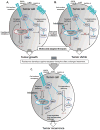Resistance to chemotherapy and molecularly targeted therapies: rationale for combination therapy in malignant melanoma
- PMID: 21707515
- PMCID: PMC4229029
- DOI: 10.2174/156652411800615153
Resistance to chemotherapy and molecularly targeted therapies: rationale for combination therapy in malignant melanoma
Abstract
Metastatic melanoma is one of the most intractable tumors, with all current regimens showing limited survival impact. Failure of most agents is attributed to development of therapy resistance. Accumulated evidence points to the apoptotic defect of melanoma cells and the surge of survival signals stimulated by cytotoxic drugs, as a way that tumors circumvent cytotoxic chemotherapy. An overview of inhibitors developed against these growth/survival factors, which are potential partners to be combined with systemic chemotherapy, will be discussed. The escape mechanism from molecular inhibitors also suggests a "vertical" or "horizontal" combination of molecularly targeted therapies. A better understanding of the interactions between simultaneously used regimens and of the rationale for combination therapy will provide new insights to improve survival and quality of life in patients with advanced melanoma.
Figures

References
-
- Ibrahim N, Haluska FG. Molecular pathogenesis of cutaneous melanocytic neoplasms. Annu Rev Pathol. 2009;4:551–79. - PubMed
-
- Jemal A, Siegel R, Xu J, Ward E. Cancer Statistics, 2010. CA Cancer J Clin. 2010 - PubMed
-
- Lee KC, Weinstock MA. Melanoma Is Up: Are We Up to This Challenge? J Invest Dermatol. 2009;129:1604–6. - PubMed
Publication types
MeSH terms
Substances
Grants and funding
LinkOut - more resources
Full Text Sources
Medical
